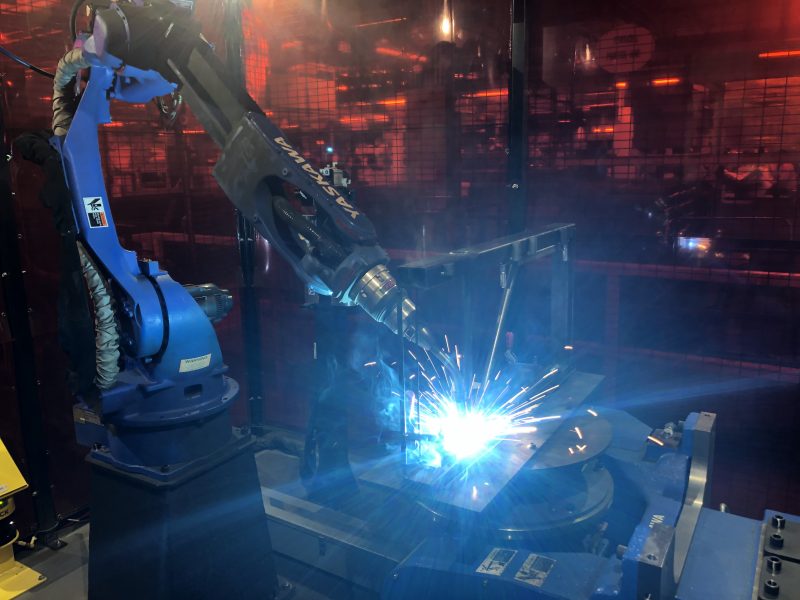After 125 years of experience as a manufacturer and supplier of mass-transportation seating products, Chicago, IL-based Freedman Seating Co. knows a thing or two about continuous-improvement initiatives and advanced-manufacturing technologies. Founded in 1894 when renowned upholster Hyman Freedman began making seat cushions for horse-drawn buggies, Freedman remains a family-owned and -operated business four generations later, producing seating products for a range of markets: bus, rail, marine and commercial/specialty, such as delivery trucks, caregiver vehicles and school buses. With its 400,000+ sq.-ft. manufacturing facility, a diverse (85-percent minority/women) workforce of 900, and forward-thinking culture, Freedman stands ready to meet today’s seating needs.

The Need for a Robotic Automation Upgrade
Recently, Freedman’s decision makers recognized an opportunity to improve its manufacturing efficiency by addressing time spent welding carbon-steel components for foldaway seat frames.
While the current process of using three robots at multiple stations to fabricate parts, plus the additional use of a hand welder at times, was safe and effective, the 18- to 20-min./part cycle time was not conducive to keeping pace with growing customer demand. Moreover, the energy spent by three human operators to set up components and transfer parts hindered optimal factory-floor workflow.
Dedicated to improving operations and keeping costs down, company leaders reached out to their robot supplier, Yaskawa Motoman, Miamisburg, OH, for a more efficient solution.
Given the nature of the application, it was determined that a compact, flexible robotic workcell—equipped with a five-axis, double-ended tilt-rotate positioner integrated with two MotoPos D500 positioners for 360-deg. rotation—was needed to streamline welding of foldaway seat T- and V-groove joints.
Optimal Weld Quality via Faster Cycle Time
After a thorough process review, and a design and building phase, Freedman Seating implemented a custom robotic-welding workcell for the manufacture of foldaway seat frames.
The solution featured a Yaskawa Motoman robot on a fabricated steel riser and an MA2010 extended-reach welding robot with through-the-arm torch cabling and a Miller Electric Continuum 350 metal-inert-gas weld package. The robot also features a ComArc seam-tracking package with 200V high-speed touch sensing function, suitable for tracking stainless-steel lap joints from 3-mm thick or more. This function assists in compensating for weld-joint location variance, helping the system produce precise, clean welds.
The custom tilt-rotate positioner combines a standard turntable base with framework to hold two MotoPos D500 tilt-rotate positioners on each side. Each servo-driven MotoPos D500 two-axis positioner has a 500-kg payload capacity with ±0.1-mm repetitive accuracy. Each can rotate ±370 deg. and tilt ±135 deg., enabling the continual welding of seat joints from 1⁄16 to 1⁄8 in. thick in continuous motion.
Coordinated motion software used in the robot controller ensures synchronized motion between the robot and positioners, with the robot and positioner axes moving in unison at an interpolated constant speed, allowing the torch to maintain optimum posture while the workpiece turns. This cohesion provides the ability to complete each safety critical weld in position—unlike the prior fabricating method—providing consistency in weld quality by always placing welds in the same location with programmed weld parameters.
A More Efficient Solution
After a successful run-through at Yaskawa Motoman headquarters, installation of the robotic workcell for the welding of seat frames began at Freedman. Within 2 weeks the system was up and running. Aiding the transition, two of Freedman Seating’s robot technicians attended Yaskawa Academy located at Yaskawa Motoman, where they learned the ins and outs of programming the robot and positioners in conjunction with coordinated motion.
Within 10 weeks of the run-through, the two technicians, along with technical experts from Yaskawa Motoman, had the system running at full capacity. Now Freedman is well on its way to achieving its return on investment within the designated 2.5-yr. payback period.
Since the workcell’s full implementation during the summer of 2018, the welding of foldaway seat frames with the new robotic system has become more efficient. Valuable time is no longer wasted by manually moving parts from station to station. Instead, the workcell’s arc welding robot, robust weld package, seam-tracking capabilities and tilt-rotate positioner work together to produce high-quality welds anticipated by customers in 7 min. or less per part for a 10-min. improvement.
The two-station system operates across two 8-hr. shifts, 5 days per week to maintain steady foldaway seat production. Instead of three robots and three human operators, the system requires just one human operator. In addition, the robotic welding workcell, with tilt-rotate positioner, has freed up the three robots to weld other parts and enabled the redeployment of two workers to other high-value operational tasks.
